Contents:
Insect pests are capable of feeding on almost all types of organic matter. The insects can cause damage to crop plants in the field, fruit plants, stored food and even the property. The pests can cause even health problems to man and his animals.
Based on the host which they affect the pests are classified as following:
1. Agricultural Pests
- Each and every agricultural crops are infested by number of pests that cause severe damage. Pest constitute a large number of insects attacking to the various crop plants.
- The immature stages or adult insects are either foliage feeders or saps suckers. These insects bear chewing and sucking type of mouth parts.
- They may be internal feeders or borers or sub-terranean inhabitants.
- The important crops like jowar, bajara, wheat, cotton, sugarcane etc. are attacked by pests like stem borer, shoot fly, Deccan wingless grasshopper, army worms, flea beetles, aphids, leafhoppers, mites, jowar midge fly etc.
- The cabbage worms, semiloopers, potato beetles, etc., possess chewing type mouth parts. They chew and swallow the external parts of the plants. While some insects i.e. blister beetle feed on pollens and petals of bajara etc. thus causing severe damage.
- Sugarcane is an important cash crop cultivated widely in Maharashtra. This single crop is infested by sugarcane stem borer, shoot borer moth, root borer, Pyrilla, mealy bug, scale insects etc.
- The cutworms, leafhoppers, potato tuber moth, epilachna beetles, mites, aphids and thrips cause injuries to potato crop and vegetables in field as well as in the storage. The cabbage leaf miner and cabbage caterpillars spoil the cabbage crop seriously.
- The Rhinoceros beetle, mango stem borer, brinjal fruit borer, ber fruit borer infesting the variety of fruits in the field as well as in the storage.
- The thrips, Aphids, Flea beetles, etc. damage grapes, resulting to great economic loss; if not controlled properly.
- The chickoo moth and rhinoceros beetles cause damage to chickoo and coconuts. Thus, large number of pest organisms cause serious damage to many agricultural crop plants if not controlled properly.
- Insects of this group, enter into the plant body and cause deformations in the structure and function of different organs of the plants i.e. stem borers enter stem or shoot cause tunnelling inside and swelling.
- The leaf roller and leaf cutter cause severe defoliation. Gall insect cause swelling, bark feeder destroy surface of stem.
- Example, Bark beetle destroys the timber in the forests; the termites damage the timber logs even after leaving the forest
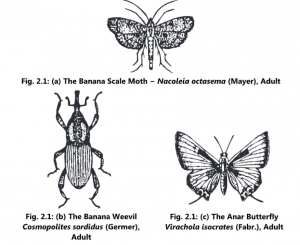
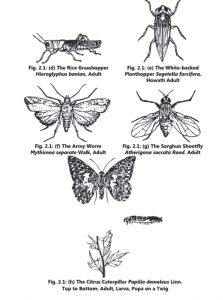
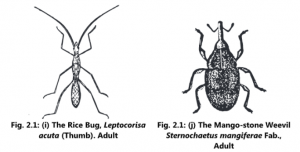
2. Household Pests
- The insects which cause serious health problems among human population are referred as public health pests. There are number of ways in which insects conflict with man’s comfort and pleasure.
- These insect pests are annoying by their presence, bad odour, their sounds and tastes of their secretions by crawling over the human body, by getting into the eyes, ears and nose or by laying their eggs on animal bodies.
- We have experience of flying, buzzing of insects, particularly when we desire to rest or sleep.
- The diverse environments around us are very attractive to insects, including lawns, flowers, shrubs, parks, industrial complexes and dwellings.
- Pests that infest dwellings are commonly referred to as household pests (insects). Household insects are direct concern to man, his possessions and his immediate environment.
- Insects such as cockroaches, crickets, house flies, fruit flies, weevils, ants (red and black), and silver fish etc. which contaminate eatable food and spoil it or transmitting disease causing agents are commonly placed under this group.
- The insects like cloth moths, carpet beetle, furniture beetles cause damage to property (human-possessions) also belongs to household pets.
- Thus, all types of insects which are unwanted guests in the dwellings of man, which cause damage to human holdings and his health, are called as household pests.
- The Anopheles mosquitoes spread malaria among human beings, whereas Culex and Aedes spreads filariasis and yellow fever respectively.
- Human louse (Pediculus) carries micro-organisms which cause typhus fever, relapsing fever and trench fever.
- Housefly is equally important to spreading diseases like typhus fever, cholera, diarrhoea, leprosy, tuberculosis etc.
- Rat flea (Xenopsylta) works as vector for Pasteurella pestis cause Bubonic plague, and Tse tse fly (Ghossina palpalis) transmits African sleeping sickness.

3. Storage Grain Pests
- The storage of food grains has been a long practice with cultivators and traders. Considerable losses both in quality and quantity of food grains take place in storage due to number of factors.
- Organisms like insects, mites, rodents, fungi and bacteria are directly responsible for causing loss in stored products.
- It is estimated that about 7-10% stored grains are lost every year due to stored grain pest in India.
- The stored food grains, seeds, fruits, nuts etc. are infected by the internal borer insects in the kothis, godowns and warehouses are most injurious of all insects. The borers can attack them, even during the harvesting stage in the farm land itself.
- The grain weevils (pulse beetle, rice weevils), moths, red rust flour beetle, etc. cause a major damage to stored cereals (wheat, rice, bajara, barley, corn, oat, millets etc.) and pulses (lentils, peas, beans, grain etc.) respectively.
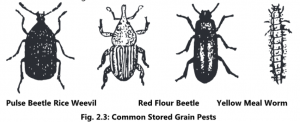
- Mainly the insects spoil the stored food grains and render them unfit for human consumption, sowing purposes. The stored grain pest can be differentiated into two types viz.(i) Primary type: This group of pests causes damage to intact grains i.e. uncrushed state.(ii) Secondary type: This group of pests feed or attacks the broken or crushed grains.
4. Structural Pests
- Structural pests are those harmful insects which cause damage to wooden frames, doors, furnitures, fencing posts, library books, stored papers, cardboards and all other wooden articles and components of buildings are referred as structural pests.
- The termites (i.e. white ants) are colonial and social insects, feed on cellulose, and damage wooden material in variable form.
- Silver fishes feed on starch material and ghee, thus damaging book bindings, wall papers, photographs and all kinds of adhesive labels. Cloth moths and carpet beetles can also be damage cloths, carpets as structural pests.
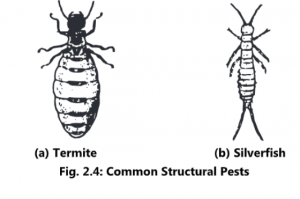
5. Veterinary Pests
- The insects which cause damage to domestic animals like chicken, horses, cattle etc. And blood sucking insects like fleas, lice, bugs, mosquitoes, stable flies as ectoparasites are the examples of domestic animal pests.
- A biting lice like Mallophaga cause irritation and loss of flesh in poultry farms.
- Tabanid flies, horn flies suck the blood from cattle and horses. Both flies cause serious stomach disturbances in horses.
- Grubs of OX-warble flies cause loss of flesh in cattle and can cause damage to the leather by cutting holes in the skin.

6. Forestry and Nursery Pests
- Insects of this group enter into the plant body and cause deformations in the structure and function of different organs of the forest and nursery plants and trees i.e. stem borers enter stem/shoot cause tunneling inside and swelling.
- The leaf roller and leaf cutter cause severe defoliation.
- Gall insects cause swelling, bark feeder destroy surface of stem. e.g. Bark beetle destroys the timber in the forests, the termites damage the timber logs even after leaving the forest.
- The sap suckers such as plant bugs, Aphids and Thrips suck plant juice of nursery plants which inhibit the photosynthetic activity.